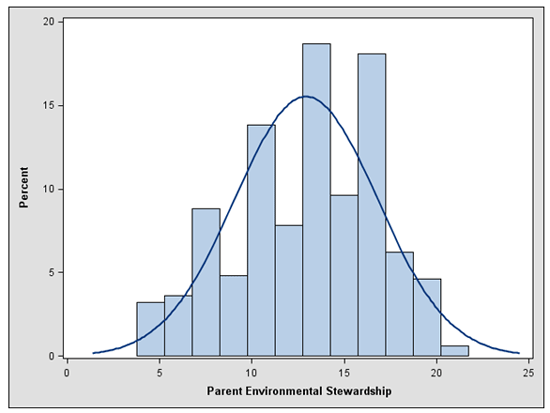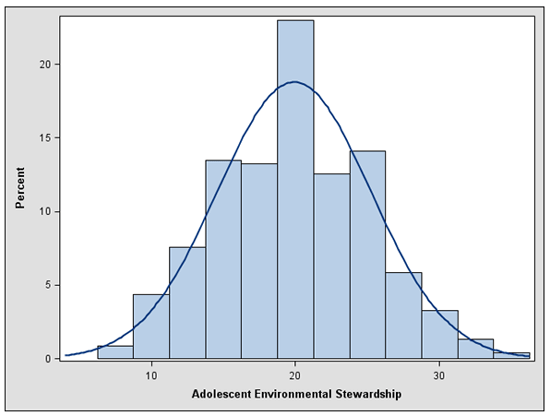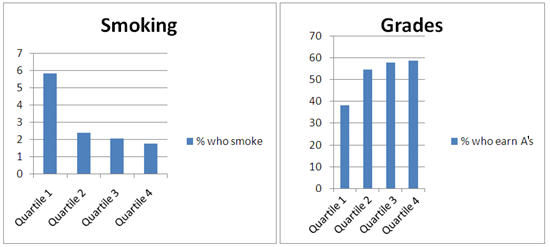Environmental Stewardship
Definition
The practice of caring for or improving the earth’s environment by:
-
Being informed
-
Taking or recognizing responsibility
-
Taking action
Parent Scale
Please indicate how much these statements describe your child. (Not at all like my child, A little like my child, Somewhat like my child, A lot like my child, Exactly like my child)
-
My child feels that there is no need to change how he/she lives to protect the earth’s environment
(Strongly agree, Somewhat agree, Neither agree nor disagree, Somewhat disagree, Strongly disagree)
-
My child does his/her part to take care of the environment.
How often, during the last month, has your child done any of the following? (Never, Once or twice a month, Once or twice a week, Almost every day)
-
Turned off and unplugged his/her electronics when he/she is not using them.
-
Recycled cans or bottles.
-
Recycled paper.
-
Volunteered on a project to help the environment.
Parent Scale Psychometric Properties and Fit Indices
We conducted confirmatory factor analysis (CFA) to examine whether responses to the scale appeared to measure a single construct. Along with Cronbach’s alpha, we present model fit indices below.

-
Alpha = 0.76 (good)
-
CFI = 0.996 (excellent)
-
TLI = 0.992 (excellent)
-
RMSEA = 0.036 (adequate)
Adolescent Scale
Please indicate how much these statements describe you. (Not at all like me, A little like me, Somewhat like me, A lot like me, Exactly like me)
-
I believe there is no need to change how I live to protect the earth’s environment.
(Strongly agree, Somewhat agree, Neither agree nor disagree, Somewhat disagree, Strongly disagree)
-
I look for information about how my actions affect the environment
-
I do my part to take care of the environment.
How often, during the last month, have you done any of the following? (Never, Once or twice a month, Once or twice a week, Almost every day)
-
Turned off and unplugged your electronics when you are not using them.
-
Recycled cans or bottles.
-
Recycled paper.
-
Volunteered on a project to help the environment.
-
Said something to a friend when they did something harmful to the environment.
-
Used reusable bags when shopping.
Adolescent Scale Psychometric Properties and Fit Indices

-
Alpha=0.76 (good)
-
CFI=0.986 (excellent)
-
TLI=0.988 (excellent)
-
RMSEA=0.059 (adequate)
Subgroup Model Fit
We tested the final adolescent and parent models with subgroups to examine whether the model fit for different subsets of respondents in the same manner as the overall sample. Using the same fit statistic requirements as the overall models, a check mark indicates that the model fit for the subgroup. Household income is defined as “low” if it is less than the median income in the sample. “High” household income indicates that the household income was equal to or greater than the sample’s median.

Concurrent Validity
Four single item measures were used to examine the concurrent validity of the adolescent scale: a measure of social behavior (fighting), a measure of health behavior (smoking), a measure of emotional health (adolescent-reported depressive symptoms), and a measure of cognitive development (grades).
Concurrent validity was examined in two ways: with bivariate and multivariate analyses. The table below presents the results of multivariate analyses, which control for: teen gender, teen age, teen race, household income, household size, parental education, parental marital status, parental home ownership, parental employment, and metropolitan area and region of residence. The beta coefficient of the relationship between the construct’s scale and outcome is presented.

The graphs below show the bivariate relationships between the adolescent scale and outcomes. Results are presented for relationships that were at least moderately significant (at the 0.10 level) in the multivariate analyses. Note that the y axis scales are different in each graph.

© Copyright 2024 ChildTrendsPrivacy Statement
Newsletter SignupLinkedInYouTube